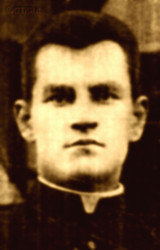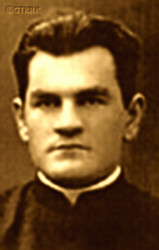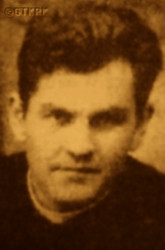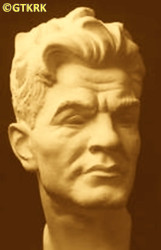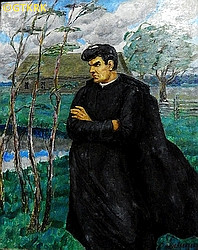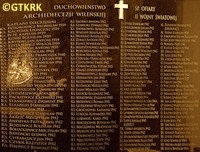Roman Catholic
St Sigismund parish
05-507 Słomczyn
85 Wiślana Str.
Konstancin deanery
Warsaw archdiocese, Poland
full list:
displayClick to display full list

searchClick to search full list by categories
wyświetlKliknij by wyświetlić pełną listę po polsku

szukajKliknij by przeszukać listę wg kategorii po polsku

Martyrology of the clergy — Poland
XX century (1914 – 1989)
personal data
surname
GLAKOWSKI
surname
versions/aliases
HLAKOŬSKI
forename(s)
Stanislav (pl. Stanisław)
function
diocesan priest
creed
Latin (Roman Catholic) Church RCmore on
en.wikipedia.org
[access: 2014.09.21]
diocese / province
Vilnius archdiocesemore on
en.wikipedia.org
[access: 2013.05.19]
Vilnius diocesemore on
en.wikipedia.org
[access: 2013.05.19]
academic distinctions
Doctor of Theology
nationality
Belarusian
date and place
of death
12.1941

Minsktoday: Minsk city reg., Belarus
more on
en.wikipedia.org
[access: 2020.07.31]
alt. dates and places
of death
1942, 1943
KL Buchenwaldconcentration camp
today: n. Weimar, Weimar urban dist., Thuringia state, Germany
more on
en.wikipedia.org
[access: 2022.01.09]
KL Auschwitzconcentration camp
today: Oświęcim, Oświęcim gm., Oświęcim pov., Lesser Poland voiv., Poland
more on
en.wikipedia.org
[access: 2022.01.09]
details of death
After German and Russian invasion of Poland in 09.1939 and start of the World War II, after German attack on 22.06.1941 of their erstwhile ally, Russians, and start of German occupation went to Minsk.
There ministered without proper canonical permissions.
Suspended by Abp Jałbrzykowski, Apostolic administrator for Minsk diocese (the decision prob. did not reach him).
During Belarusian school inspectors' conference in Minsk on 15.12.1941 did not raise his arm in salute when German anthem was played out.
Arrested by the Germans, together with Fr Denis Malec among others.
Prob. murdered in Minsk prison.
alt. details of death
According to other sources perished in German KL Auschwitz or KL Buchenwald concentration camp.
cause of death
extermination
perpetrators
Germans
sites and events
MinskClick to display the description, KL BuchenwaldClick to display the description, KL AuschwitzClick to display the description, Ribbentrop‐MolotovClick to display the description, Pius XI's encyclicalsClick to display the description
date and place
of birth
02.03.1896

Porazavatoday: Porazava ssov., Svislach dist., Grodno reg., Belarus
more on
en.wikipedia.org
[access: 2022.01.06]
parents
GLAKOWSKI Anthony
🞲 ?, ? — 🕆 ?, ?

Antonina
🞲 ?, ? — 🕆 ?, ?
presbyter (holy orders)
ordination
29.05.1921

Vilniustoday: Vilnius city dist., Vilnius Cou., Lithuania
more on
en.wikipedia.org
[access: 2022.01.06]
positions held
1938 – 1941
vicar — Vilniustoday: Vilnius city dist., Vilnius Cou., Lithuania
more on
en.wikipedia.org
[access: 2022.01.06] ⋄ St John the Baptist and St John the Evangelist RC parish ⋄ Vilniustoday: Vilnius city dist., Vilnius Cou., Lithuania
more on
en.wikipedia.org
[access: 2022.01.06] RC deanery
from 1929
prefect — Vilniustoday: Vilnius city dist., Vilnius Cou., Lithuania
more on
en.wikipedia.org
[access: 2022.01.06] ⋄ Thaddeus Czacki's gymnasium and the Belarusian Gymnasium ⋄ St John the Baptist and St John the Evangelist RC parish ⋄ Vilniustoday: Vilnius city dist., Vilnius Cou., Lithuania
more on
en.wikipedia.org
[access: 2022.01.06] RC deanery — Church law teacher
1928 – 1929
parish priest — Tryczówkatoday: Juchnowiec Kościelny gm., Białystok pov., Podlaskie voiv., Poland
more on
en.wikipedia.org
[access: 2022.01.06] ⋄ Immaculate Conception of the Blessed Virgin Mary RC parish ⋄ Białystoktoday: Białystok city pov., Podlaskie voiv., Poland
more on
en.wikipedia.org
[access: 2020.12.11] RC deanery
1927 – 1928
vicar — Vawkavysktoday: Vawkavysk dist., Grodno reg., Belarus
more on
en.wikipedia.org
[access: 2022.01.06] ⋄ St WenCeslav the Prince and Martyr RC parish (main parish) ⋄ Vawkavysktoday: Vawkavysk dist., Grodno reg., Belarus
more on
en.wikipedia.org
[access: 2022.01.06] RC deanery
1926 – 1927
vicar — Trzciannetoday: Trzcianne gm., Mońki pov., Podlaskie voiv., Poland
more on
en.wikipedia.org
[access: 2022.01.06] ⋄ St Peter and St Paul the Apostles RC parish ⋄ Knyszyntoday: Knyszyn gm., Mońki pov., Podlaskie voiv., Poland
more on
en.wikipedia.org
[access: 2022.01.06] RC deanery — also: prefect of elementary schools
1926
parish priest — Downarytoday: Goniądz gm., Mońki pov., Podlaskie voiv., Poland
more on
en.wikipedia.org
[access: 2022.01.06] ⋄ Our Lady of the Angels RC parish ⋄ Knyszyntoday: Knyszyn gm., Mońki pov., Podlaskie voiv., Poland
more on
en.wikipedia.org
[access: 2022.01.06] RC deanery
c. 1926
vicar — Novyi Pogosttoday: Novyi Pogost ssov., Myory dist., Vitebsk reg., Belarus
more on
be.wikipedia.org
[access: 2023.01.18] ⋄ Holy Trinity RC parish ⋄ Myorytoday: Myory dist., Vitebsk reg., Belarus
more on
en.wikipedia.org
[access: 2024.03.19] RC deanery
1923 – 1926
PhD student — Rometoday: Rome prov., Lazio reg., Italy
more on
en.wikipedia.org
[access: 2021.12.18] ⋄ Pontifical Oriental Institute (Lat. Pontificium Institutum Orientale) — PhD thesis Lat. „Oratio secundum diarium Joannis de Cronstadt «Mea vita in Christo»” (Eng. „Oration according to the diary of John of Cronstadt «My life in Christ»”), public defense in 1926, ed. Vilnius 1937, without „imprimatur” of the clerical authorities
1921 – 1923
chaplain — Vilniustoday: Vilnius city dist., Vilnius Cou., Lithuania
more on
en.wikipedia.org
[access: 2022.01.06] ⋄ Divine Providence RC church ⋄ Vilniustoday: Vilnius city dist., Vilnius Cou., Lithuania
more on
en.wikipedia.org
[access: 2022.01.06] RC deanery
1914 – 1921
student — Vilniustoday: Vilnius city dist., Vilnius Cou., Lithuania
more on
en.wikipedia.org
[access: 2022.01.06] ⋄ philosophy and theology, Theological Seminary
organizer — children's magazine, „Praleski” — also: publisher
activist — Byelorussian
others related
in death
MALECClick to display biography Dennis, MIODUSZEWSKIClick to display biography Anthony, BOHATKIEWICZClick to display biography Mieczyslav, GODLEWSKIClick to display biography Vincent, HLEBOWICZClick to display biography Henry, KASZYRAClick to display biography George, LESZCZEWICZClick to display biography Anthony, LUBECKIClick to display biography Alexander, LUBIANIECClick to display biography Charles, MARCINIAKClick to display biography Isidore, RYBAŁTOWSKIClick to display biography Casimir, ŚWIATOPEŁK–MIRSKIClick to display biography Anthony, WIECZOREKClick to display biography Vladislav
sites and events
descriptions
Minsk: Russian prison. In 1937 site of mass murders perpetrated by the Russians during a „Great Purge”. After Russian invasion of Poland in 09.1939 and start of the World War II place of incarceration of many Poles, In 06.1941, under attack by Germans, Russians murdered there a group of Polish prisoner kept in Central and co‐called American prisons in Mińsk. The rest were driven towards Chervyen in a „death march” (10,000‐20,000 prisoners perished), into Russia. (more on: pl.wikipedia.orgClick to attempt to display webpage
[access: 2013.08.17])
KL Buchenwald: In German Germ. Konzentrationslager (Eng. concentration camp) KL Buchenwald concentration camp, founded in 1937 and operational till 1945, Germans held c. 238,380 prisoners and murdered approx. 56,000 of them, among them thousands of Poles. Prisoners were victims of pseudo‐scientific experiments, conducted among others by Behring‐Werke from Marburg and Robert Koch Institute from Berlin companies. They slaved for Gustloff in Weimar and Fritz‐Sauckel companies manufacturing armaments. To support Erla‐Maschinenwerk GmbH in Leipzig, Junkers in Schönebeck (airplanes) and Rautal in Wernigerode Germans organized special sub‐camps. In 1945 there were more than 100 such sub‐camps. Dora concentration camp was initially one of them, as well as KL Ravensbrück sub‐camps (from 08.1944). On 08.04.1945 Polish prisoner, Mr Guido Damazyn, used clandestinely constructed short wave transmitter to sent, together with a Russian prisoner, a short message begging for help. It was received and he got a reply: „KZ Bu. Hold out. Rushing to your aid. Staff of Third Army” (American). Three days later the camp was liberated. (more on: www.buchenwald.deClick to attempt to display webpage
[access: 2013.08.10], en.wikipedia.orgClick to attempt to display webpage
[access: 2013.08.10])
KL Auschwitz: German Germ. Konzentrationslager (Eng. concentration camp) KL and Germ. Vernichtungslager (Eng. extermination camp) VL Auschwitz was set up by Germans around 27.01.1940 n. Oświęcim, on the German territory (initially in Germ. Provinz Schlesien — Silesia Province; and from 1941 Germ. Provinz Oberschlesien — Upper Silesia Province). Initially mainly Poles were interned. From 1942 it became the centre for holocaust of European Jews. Part of the KL Auschwitz concentration camps’ complex was Germ. Vernichtungslager (Eng. extermination camp) VL Auschwitz II Birkenau, located not far away from the main camp. There Germans murdered likely in excess of million people, mainly Jews, in gas chambers. In KL Auschwitz alone, the Germans murdered c. 30,000 prisoners by lethal injection. Until 1941, people were killed by intravenous injections of concentrated hydrogen peroxide, ether, hydrogen peroxide, or gasoline. Later, an intracardiac injection was used — with a needle about 10 cm long — of 10‐15 ml of a 30% solution of phenol C6H5OH (acquired from the German concern IG Farben, or more precisely from its subsidiary Bayer, and still used by Bayer AG, among others, for the production of aspirin), which killed within 15 seconds. Altogether In excess of 400 priests and religious went through the KL Auschwitz, c. 40% of which were murdered (mainly Poles). (more on: en.auschwitz.org.plClick to attempt to display webpage
[access: 2012.11.23], www.meczennicy.pelplin.plClick to attempt to display webpage
[access: 2013.07.06])
Ribbentrop‐Molotov: Genocidal Russian‐German alliance pact between Russian leader Joseph Stalin and German leader Adolf Hitler signed on 23.08.1939 in Moscow by respective foreign ministers, Mr. Vyacheslav Molotov for Russia and Joachim von Ribbentrop for Germany. The pact sanctioned and was the direct cause of joint Russian and German invasion of Poland and the outbreak of the World War II in 09.1939. In a political sense, the pact was an attempt to restore the status quo ante before 1914, with one exception, namely the „commercial” exchange of the so‐called „Kingdom of Poland”, which in 1914 was part of the Russian Empire, fore Eastern Galicia (today's western Ukraine), in 1914 belonging to the Austro‐Hungarian Empire. Galicia, including Lviv, was to be taken over by the Russians, the „Kingdom of Poland” — under the name of the General Governorate — Germany. The resultant „war was one of the greatest calamities and dramas of humanity in history, for two atheistic and anti‐Christian ideologies — national and international socialism — rejected God and His fifth Decalogue commandment: Thou shall not kill!” (Abp Stanislav Gądecki, 01.09.2019). The decisions taken — backed up by the betrayal of the formal allies of Poland, France and Germany, which on 12.09.1939, at a joint conference in Abbeville, decided not to provide aid to attacked Poland and not to take military action against Germany (a clear breach of treaty obligations with Poland) — were on 28.09.1939 slightly altered and made more precise when a treaty on „German‐Russian boundaries and friendship” was agreed by the same murderous signatories. One of its findings was establishment of spheres of influence in Central and Eastern Europe and in consequence IV partition of Poland. In one of its secret annexes agreed, that: „the Signatories will not tolerate on its respective territories any Polish propaganda that affects the territory of the other Side. On their respective territories they will suppress all such propaganda and inform each other of the measures taken to accomplish it”. The agreements resulted in a series of meeting between two genocidal organization representing both sides — German Gestapo and Russian NKVD when coordination of efforts to exterminate Polish intelligentsia and Polish leading classes (in Germany called «Intelligenzaktion», in Russia took the form of Katyń massacres) where discussed. Resulted in deaths of hundreds of thousands of Polish intelligentsia, including thousands of priests presented here, and tens of millions of ordinary people,. The results of this Russian‐German pact lasted till 1989 and are still in evidence even today. (more on: en.wikipedia.orgClick to attempt to display webpage
[access: 2015.09.30])
Pius XI's encyclicals: Facing the creation of two totalitarian systems in Europe, which seemed to compete with each other, though there were more similarities than contradictions between them, Pope Pius XI issued in 03.1937 (within 5 days) two encyclicals. In the „Mit brennender Sorge” (Eng. „With Burning Concern”) published on 14.03.1938, condemned the national socialism prevailing in Germany. The Pope wrote: „Whoever, following the old Germanic‐pre‐Christian beliefs, puts various impersonal fate in the place of a personal God, denies the wisdom of God and Providence […], whoever exalts earthly values: race or nation, or state, or state system, representatives of state power or other fundamental values of human society, […] and makes them the highest standard of all values, including religious ones, and idolizes them, this one […] is far from true faith in God and from a worldview corresponding to such faith”. On 19.03.1937, published „Divini Redemptoris” (Eng. „Divine Redeemer”), in which criticized Russian communism, dialectical materialism and the class struggle theory. The Pope wrote: „Communism deprives man of freedom, and therefore the spiritual basis of all life norms. It deprives the human person of all his dignity and any moral support with which he could resist the onslaught of blind passions […] This is the new gospel that Bolshevik and godless communism preaches as a message of salvation and redemption of humanity”… Pius XI demanded that the established human law be subjected to the natural law of God , recommended the implementation of the ideal of a Christian state and society, and called on Catholics to resist. Two years later, National Socialist Germany and Communist Russia came together and started World War II. (more on: www.vatican.vaClick to attempt to display webpage
[access: 2023.05.28], www.vatican.vaClick to attempt to display webpage
[access: 2023.05.28])
sources
personal:
www.bialystok.opoka.org.plClick to attempt to display webpage
[access: 2013.01.06], kamunikat.orgClick to attempt to display webpage
[access: 2013.01.06], cyclowiki.orgClick to attempt to display webpage
[access: 2015.04.18], www.spotkania-na-wschodzie.plClick to attempt to display webpage
[access: 2012.11.23]
bibliographical:
„Vilnius archdiocese clergy martyrology 1939‐1945”, Fr Thaddeus Krahel, Białystok, 2017
original images:
westki.infoClick to attempt to display webpage
[access: 2015.05.09], cyclowiki.orgClick to attempt to display webpage
[access: 2015.04.18], audiovis.nac.gov.plClick to attempt to display webpage
[access: 2020.07.31], znadniemna.plClick to attempt to display webpage
[access: 2022.01.06], www.ciekawepodlasie.plClick to attempt to display webpage
[access: 2020.07.31]
LETTER to CUSTODIAN/ADMINISTRATOR
If you have an Email client on your communicator/computer — such as Mozilla Thunderbird, Windows Mail or Microsoft Outlook, described at WikipediaPatrz:
en.wikipedia.org, among others — try the link below, please:
LETTER to CUSTODIAN/ADMINISTRATORClick and try to call your own Email client
If however you do not run such a client or the above link is not active please send an email to the Custodian/Administrator using your account — in your customary email/correspondence engine — at the following address:

giving the following as the subject:
MARTYROLOGY: GLAKOWSKI Stanislav
To return to the biography press below:
 Click to return to biography
Click to return to biography








